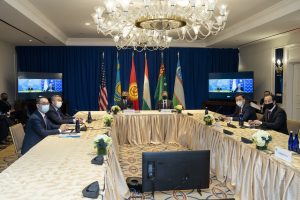Much ink has been spilled over the United States’ withdrawal from Afghanistan, and the final chapter of America’s 20-year saga in the country will continue to be closely analyzed for years to come. But as the dust settles in Kabul, one serious question remains worth asking: What if the U.S. had needed some form of assistance and subsequent calls for help had gone unanswered? It’s hard to fathom just how much more chaotic the evacuation process could have been if calls for much-needed help were spurned.
Fortunately, that question remains hypothetical for now. For example, both Turkey and Azerbaijan played critical roles in the evacuation process, from providing security contingents around the airport in Kabul to operating a logistical hub out of Baku for planes assisting in the evacuation. The importance of this cooperation simply cannot be overstated in contributing to Washington’s ability to expedite its withdrawal from Afghanistan.
That said, while the U.S. military engagement in Afghanistan has officially drawn to a close, broader strategic imperatives in Central Asia and the Caucasus have no such end in sight. The most clear and present issues – such as the rising geopolitical threats of both Russia and China – demand international cooperation. The more nebulous prospects, like the threat of resurgent Islamic extremism in the region, will require proactive collaboration on the part of the U.S. and its allies. Each of these instances points to the need for an innovative U.S. diplomatic approach in Central Asia. Ultimately, the U.S. will find success only through revitalizing – and cementing – its relationships with key allies in the region.
The need for U.S. visibility and engagement across Eurasia – through proactive, innovative diplomatic approaches – is clear. To that end, it’s worth reiterating the tenets of the U.S. strategy for Central Asia, which, as outlined by the U.S. Department of State in February 2020, consists of the following six pillars: Support and strengthen the sovereignty and independence of the Central Asian States, individually and as a region; reduce terrorist threats in Central Asia; expand and maintain support for stability in Afghanistan; encourage connectivity between Central Asia and Afghanistan; promote rule of law reform and respect for human rights; and promote United States investment in and development of Central Asia.
These principles not only capture enduring mutual interests but also serve as a timely reminder that the United States’ foreign policy objectives in the region have not changed, despite the tumultuous events of recent weeks. It’s critical to reinforce this point, as states in Central Asia have been subject to rapidly shifting and disruptive economic, security, and political issues that potentially threaten internal stability. The U.S. can provide a steady hand and reiterate its support for critical allies in the region.
Importantly, this approach must start with the U.S. addressing the near-term issues that front-line states now face as a result of the withdrawal from Afghanistan. These concerns will include border security, population migration and displacement, humanitarian relief for displaced persons, as well as countering illicit trafficking of drugs and armaments. It will be critical to arrive at a consensus to determine immediate solutions to questions such as how many Afghanistan refugees neighboring countries should take for the indeterminate future, what role the U.N. should play in this process, as well as how to address the outflow of left-behind weaponry and subsequent stability threats.
Moreover, enhanced engagement will be especially critical in light of increased pressure coming from Russia and China. The U.S. withdrawal was a messaging heyday on the part of both countries, with one Chinese foreign ministry spokeswoman commenting, “American myth down,” while a Russian RT broadcaster concluded, “The moral of the story is: don’t help the Stars and Stripes.” Beyond PR efforts, China also stepped into the foreign aid vacuum, announcing that it would send $31 million worth of food and health supplies to Afghanistan. But ultimately, it is axiomatic that Russia will fill any security vacuum or counter what it perceives as instability on its periphery.
One danger that will confront all countries in the region is the potential for a resurgence in Islamic extremism. Central Asian states could well see emboldened Islamist movements in their own nations after witnessing the success of the Taliban in Afghanistan – and in fact, China has already expressed concerns over the East Turkestan Islamic Movement (ETIM). With the potential for similar radical extremist ideologies to take hold in the region, a coordinated and strategic approach to countering those threats will be paramount.
Ultimately, “innovative diplomacy” has to be more than a concept or words out of Washington. In remarks regarding Afghanistan, President Joe Biden called for a “new era” of the use of American power. He’s right – and many lessons will continue to be drawn from the U.S. withdrawal from Afghanistan. American policymakers should ensure that this new era reflects the need for sustained engagement and cooperation with its allies in the Caspian region. The most urgent need right now is for very high-level U.S. visits to the key countries of the region to demonstrate that the United States clearly understands their current anxiety and is committed to finding long term cooperative solutions. Further, future U.S. actions in the region have to instill faith and confidence in our willingness and ability to be a partner for stability and development in the region. Good intentions and messaging will not cut it this time around; the U.S. must increase the visibility of its initiatives as well as its high-level visits in order to be a force for good and for progress.

































